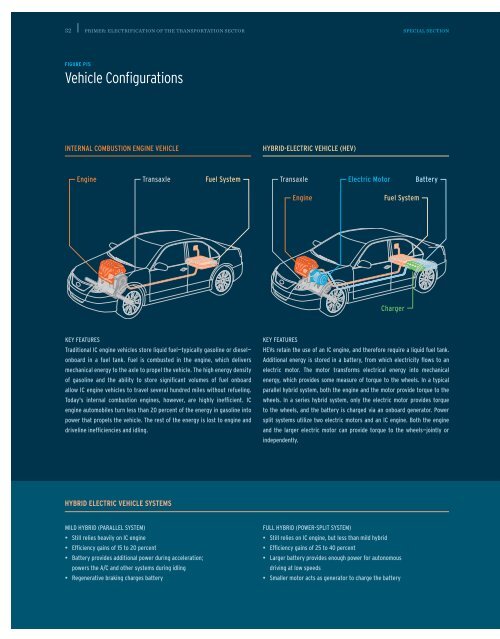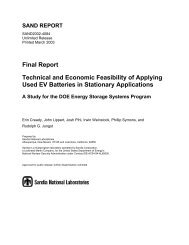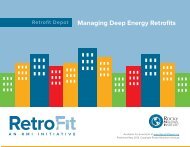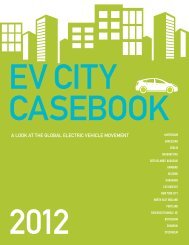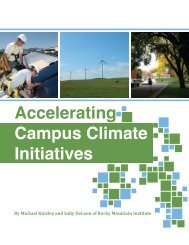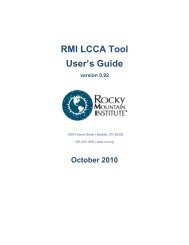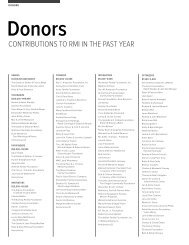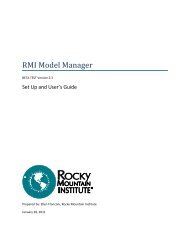Fleet Electrification Roadmap
Fleet Electrification Roadmap
Fleet Electrification Roadmap
- No tags were found...
Create successful ePaper yourself
Turn your PDF publications into a flip-book with our unique Google optimized e-Paper software.
32 primer: electrification of the transportation sectorspecial sectionspecial sectionfleet electrification roadmap 33FIGURE P15Vehicle ConfigurationsToday's familiar hybrid-electric vehicles offer improved efficiency over traditional internalcombustion engine automobiles. However, by incorporating a larger battery and drawing electricpower from the grid, plug-in hybrids and pure electric vehicles offer a step change improvementin energy security.INTERNAL COMBUSTION ENGINE VEHICLE HYBRID-ELECTRIC VEHICLE (HEV) PLUG-IN HYBRID ELECTRIC VEHICLE (PHEV) ELECTRIC VEHICLE (EV)Engine Transaxle Fuel SystemTransaxleElectric MotorBattery TransaxleElectric Motor Battery TransaxleBatteryEngineFuel SystemEngineFuel SystemElectric MotorGeneratorCharger Plug & Charger Plug & ChargerKEY FEATURESTraditional IC engine vehicles store liquid fuel—typically gasoline or diesel—onboard in a fuel tank. Fuel is combusted in the engine, which deliversmechanical energy to the axle to propel the vehicle. The high energy densityof gasoline and the ability to store significant volumes of fuel onboardallow IC engine vehicles to travel several hundred miles without refueling.Today's internal combustion engines, however, are highly inefficient. ICengine automobiles turn less than 20 percent of the energy in gasoline intopower that propels the vehicle. The rest of the energy is lost to engine anddriveline inefficiencies and idling.KEY FEATURESHEVs retain the use of an IC engine, and therefore require a liquid fuel tank.Additional energy is stored in a battery, from which electricity flows to anelectric motor. The motor transforms electrical energy into mechanicalenergy, which provides some measure of torque to the wheels. In a typicalparallel hybrid system, both the engine and the motor provide torque to thewheels. In a series hybrid system, only the electric motor provides torqueto the wheels, and the battery is charged via an onboard generator. Powersplit systems utilize two electric motors and an IC engine. Both the engineand the larger electric motor can provide torque to the wheels—jointly orindependently.KEY FEATURESLike traditional hybrids, PHEVs retain the use of an internal combustionengine and fuel tank while adding a battery and electric motor. However,PHEVs utilize much larger batteries, which can be charged and rechargedby plugging into the electric grid. PHEV batteries are capable of poweringthe vehicle purely on electricity at normal speeds over significant distances(approximately 40 miles) without any assistance from the IC engine. Whenthe battery is depleted, PHEVs use the IC engine as a generator to power theelectric motor and extend their range by several hundred miles. PHEVs canbe configured as a series hybrid system or a power split system.KEY FEATURESEVs do not incorporate an IC engine or conventional fuel system. Electricvehicles rely on one or more electric motors that receive power from anonboard battery to provide the vehicle's propulsion and operation of itsaccessories. EV batteries, which are typically larger than batteries in HEVsor PHEVs to support vehicle range, are charged by plugging the car into adevice (electric vehicle service equipment) that receives electrical powerfrom the grid.HYBRID ELECTRIC VEHICLE SYSTEMSPLUG-IN HYBRID ELECTRIC VEHICLE SYSTEMSMILD HYBRID (PARALLEL SYSTEM)• Still relies heavily on IC engine• Efficiency gains of 15 to 20 percent• Battery provides additional power during acceleration;powers the A/C and other systems during idling• Regenerative braking charges batteryFULL HYBRID (POWER-SPLIT SYSTEM)• Still relies on IC engine, but less than mild hybrid• Efficiency gains of 25 to 40 percent• Larger battery provides enough power for autonomousdriving at low speeds• Smaller motor acts as generator to charge the batteryPHEV (SERIES HYBRID SYSTEM)• Only electric motor provides torque to wheels• IC engine serves only to augment the battery after depletion• Uses no gasoline while battery is sufficiently charged• Charges battery through grid connection andregenerative brakingPHEV (POWER-SPLIT SYSTEM)• Both the motor and IC engine can provide torque tothe wheels• IC engine provides torque when required (blended mode)• Charges battery through grid connection andregenerative braking


